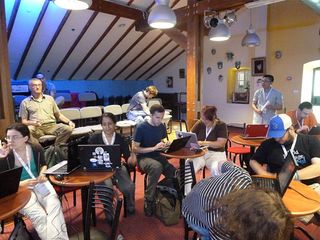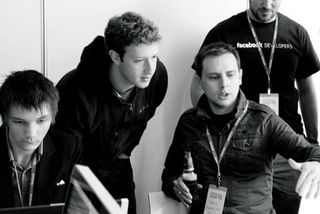When it's okay to work through the night
Paul Wyatt is hacked off with the culture of late-night working, but he's happy to work late on a hackathon.
"A good deed never goes unpunished," so the saying goes and, having stridently volunteered to take part in my first hackathon, I slowly began to realise exactly what that maxim means.
My tweet to advertise my involvement yielded a single retweet. "Hey guys, this is for charity," I say. "Give it some support". Nothing. Nadda. Zip. Zilch. Tumbleweed rolls by.
What's a hackathon?
Hackathons began to spring up in the mid-noughties where volunteers assembled to work over intense periods, from one day up to a week, on software projects.
These focused efforts usually end up with prototypes of apps or other software services, which can then be given further investment by venture capitalists or a prize fund awarded to the winning group. Those usually taking part include developers, designers and project managers.

Now this is a good thing. People have been exhausting themselves in the name of good causes and innovation for years, so why the solitary retweet?
In the creative industries as a whole, we've a particularly bad reputation for working unpaid long hours. Large agencies have been known to regularly take their pound of flesh from staff working all hours to deliver a usually badly briefed and managed campaign.
This can be expected with any job but seems to be unhappily consistent in our industry. A certain cynicism has snuck in as to why anyone would volunteer their services in late night working.
Beasts of the night
The rise of the hackathon holds a mirror up to how we're perceived as an industry, as beasts of the night, happy to burn the midnight oil should you stick a pizza and beer next to us, and unable to say it's a job well done unless we've spent three nights in a row working on it. Tight deadlines will always happen, but when that way of working is expected, something is going very wrong.
Other issues arise about ownership of the work produced and, at times, a trading on the perceived competitiveness between creatives and coders to produce high quality work over a frantic period.

The cynicism towards hackathon style events is understandable. I almost want to shout to the client world that this isn't how we roll all the time and that planning and timelines and people getting a decent night's sleep and having a good work and life balance are good things.
Products and services take time, money and energy to develop for a reason and that's simply to make them better. Hackathons don't magically solve problems.
Why we do it
So why do it? I did it because I'm useless at running marathons or climbing mountains and, as this was a charitable cause, I wanted to use my creative skills to pitch in and help raise some cash and have some inventive fun along the way. For some perhaps it's the joyful bonhomie that exists at this type of event. Their work is also applauded by fellow teammates.
Maybe that's the hook of the hackathon. It's an appreciation of those talents which in the larger shelf stacking agencies of the world often go unthanked.
There is of course the opportunity of winning some cash and becoming a coder or designer all-star in the world wide league of hackathon fame. You can also use it just to show off what you can do … and why not?
Time and task management
My particular 48-hour hackathon didn't stretch endlessly into the night. Those taking part were savvy with their time and how tasks were distributed within their teams. Project managers were listened to and timelines created.
All the teams delivered at presentation time the next day and not one of them in the same clothes from the day before. What was created were decent prototypes that could be developed using additional time and labour to make them wonderful apps.
Of course, the cynicism could be diverted. The next hackathon challenge could be set over two normal eight-hour working days. Now that would be a challenge.
Words: Paul Wyatt
Paul Wyatt is a designer, writer and filmmaker. He produces short films, websites, apps and brand identity creative for clients such as Virgin, Sony Music, Adobe and Daft Punk. This article originally appeared in net magazine issue 249
Liked this? Read these!
- How to build an app: try these great tutorials
- Create a perfect mood board with these pro tips and tools
- Amazing examples of experimental design

Thank you for reading 5 articles this month* Join now for unlimited access
Enjoy your first month for just £1 / $1 / €1
*Read 5 free articles per month without a subscription

Join now for unlimited access
Try first month for just £1 / $1 / €1
Get the Creative Bloq Newsletter
Daily design news, reviews, how-tos and more, as picked by the editors.
The Creative Bloq team is made up of a group of design fans, and has changed and evolved since Creative Bloq began back in 2012. The current website team consists of eight full-time members of staff: Editor Georgia Coggan, Deputy Editor Rosie Hilder, Ecommerce Editor Beren Neale, Senior News Editor Daniel Piper, Editor, Digital Art and 3D Ian Dean, Tech Reviews Editor Erlingur Einarsson and Ecommerce Writer Beth Nicholls and Staff Writer Natalie Fear, as well as a roster of freelancers from around the world. The 3D World and ImagineFX magazine teams also pitch in, ensuring that content from 3D World and ImagineFX is represented on Creative Bloq.
